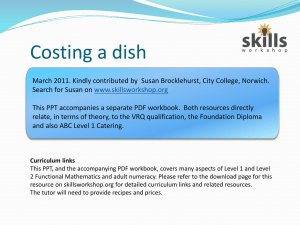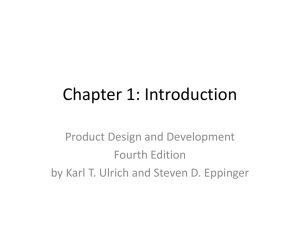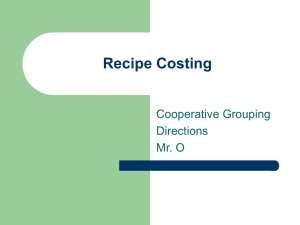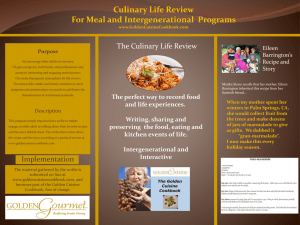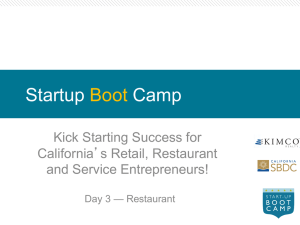what is the true cost per portion?
advertisement
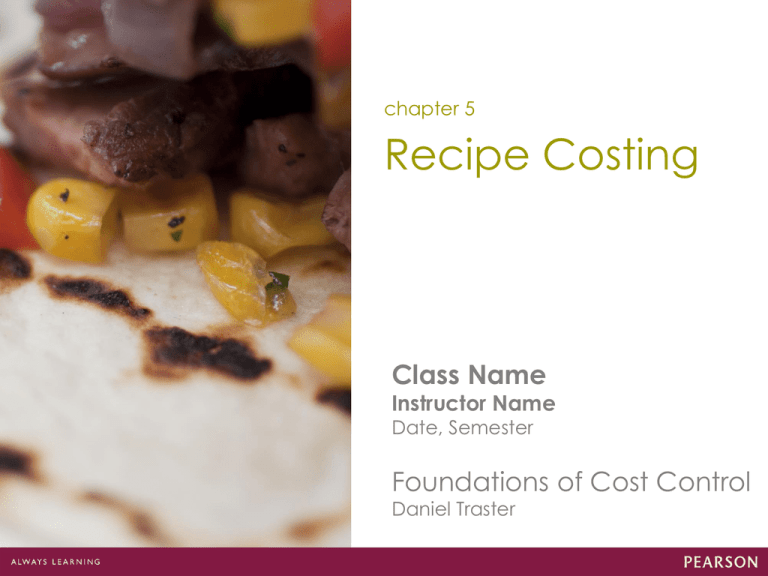
chapter 5 Recipe Costing Class Name Instructor Name Date, Semester Foundations of Cost Control Daniel Traster The Costing Sheet The goal of the costing sheet is to determine the total recipe cost and cost per portion. To complete, it requires: • A recipe with a list of ingredients and their quantities • Y% for each ingredient as it is to be prepped • AP$ for each ingredient • EP$ for any item requiring a butcher’s test 2 Costing Sheet: Heading The costing sheet heading includes the following: • Recipe Name • Number of Portions (Yield) for the recipe • Cost per Portion (calculated in the costing sheet) • Spice Factor and Q Factor • FC% and Selling Price (covered in next chapter) 3 Sample Costing Sheet before Calculations Recipe: Cous Cous with Carrots and Raisins Spice Factor: Portions: 8 Cost per portion: FC% Ingredient Quantity Y% AP$ Cous Cous 2 cups 100% $4.20/Qt Carrot, diced 4 oz 77% $0.68/# Raisins 4 oz 100% $4.37/# Chicken Stock 16 oz 100% $0.84/Qt Parsley, chopped 2 Tbsp 1 bun = 8 Tbsp $0.72/bun To taste Spice Factor Salt/Pepper To taste Q Factor: Selling Price: AP$ converted EP$ Extended $ 4 Converting Units in Costing Sheet Units in “price per unit” must match the units in the ingredient list. Invoice units and ingredient units don’t often match. 5 Common Invoice Pricing Invoices often list prices per case size, which may be broken down as number of units in a case and size per unit. • Examples: ― ― ― ― ― 12/1Qt 40# 8/5# 6/#10 cans 80 count Written as “number/number with unit” the first number is the number of containers in a case. The second is the size of each container. 6 Making Invoice Pricing Useable 1) Calculate total weight or volume as: Total wt. = number of units X weight per unit 2) For volume, substitute volume for weight. 3) Next, calculate AP$ (per unit) as: AP$ = total cost ÷ total weight (or vol.) 7 Example 5a Diced tomato costs $16.54 for a case of 6/#10 cans. Kitchen tests show a #10 can contains 6# 6oz of product. What is the cost per oz? 6# 6oz = 102 oz Total wt. = units X wt/unit = 6 X 102oz = 612oz Cost/unit = cost ÷ total wt. = $16.54 ÷ 612oz = $0.027/oz 8 Example 5b Vinegar costs $31.80 for 4/1Gal. What is the cost per cup? 1 Gal = 16 cups Total vol. = 4 units X 16 c/unit = 64 cups Cost/unit = cost ($31.80) ÷ vol. (64c) =$0.497/c 9 Possible Complications in Unit Conversion 1. Weight listed on can is not the same as product’s drained weight. • Solution: test a can and use the drained weight for the calculation. 2. Container measures contents in weight but recipe measures in volume or vice-versa. • Solution: Open container to measure volume (or weight) and use this figure for calculations. Note: In both cases, Y% is accounted for by test, so Y% becomes 100% on costing sheet. See Figure 5.1b 10 Calculating EP$ for Costing Sheet EP$ = AP$ ÷ Y% • Y% in decimal form. • Only use AP$ with units that match the ingredient’s units. • For items from a butcher’s yield test, just enter the EP$ from the test and convert to units that match the ingredient’s units. • For items with Y% = 100%, AP$ = EP$ See Figure 5.1c 11 Calculating Extended Costs or “Extension” Extended cost or extension is the total amount of money that each ingredient contributes to the total cost of the recipe. Extension = Ingredient Quantity x EP$/unit See Figure 5.1d 12 Total Recipe Cost Total Recipe Cost Sum of all ingredient extended costs 13 Cous Cous Recipe: Part II Recipe: Cous Cous with Carrots and Raisins Spice Factor: Portions: 8 Cost per portion: Q Factor: Selling Price: FC% Ingredient Quantity Y% AP$ AP$ converted EP$ Extended Cost Cous Cous 2 cups 100% $4.20/Qt $1.05/c $1.05/c $2.10 Carrot, diced 4 oz 77% $0.68/# $0.043/oz $0.056/oz $0.224 Raisins 4 oz 100% $4.37/# $0.273/oz $0.273/oz $1.092 Chicken Stock 16 oz 100% $0.84/Qt $0.026/oz $0.026/oz $0.416 Parsley, chopped 2 Tbsp 1 bun = 8 Tbsp $0.72/bun $0.09/Tbs $0.09/Tbs $0.18 Salt/Pepper To taste To taste Spice Factor S.F S.F. N/A TOTAL $4.012 14 Spice Factor (S.F.) • Adjusts recipe cost for ingredients like spices, herbs, and seasonings. • Each operation decides what ingredients are included in Spice Factor. • Saves time on costing each spice or herb separately in a recipe. • Allows for seasoning “to taste.” 15 Spice Factor S.F.) • Divides cost of spices and seasoning across all dishes rather than making heavily spices ones extremely expensive. • Can be used to account for garnishes and “reject” dishes returned by customer • Can be applied either to recipe’s total cost or to cost per portion 16 Determining the Spice Factor 1. Decide which items will be included in spice factor. Calculate cost spent on those items over a period of time. 2. If desired, include value of “reject” or ruined dishes over the same period. S.F. = value of S.F. items ÷ value of total food purchases (over the same period) 3. Convert S.F. to % form. 17 Example 5c Restaurant purchases $120,000 in food over 3 months. Spice factor items over that period are valued at $2,600. What is the restaurant’s spice factor? SF = Value of SF items ÷ total food purchases = $2,600 ÷ $120,000 = 0.0216 or 2.2% 18 Adjusting Recipe’s Cost Using S.F. SF-adjusted recipe cost = Recipe Cost x (1+S.F. in decimal form) • Use this equation on all recipes regardless of spice or herb use • If dish contains multiple components, adjust each recipe for SF. 19 Example 5d A recipe’s total cost is $27.72. SF = 2.2%. What is the SF-adjusted cost for the recipe? SF-adjusted cost = recipe cost X (1+SF) = $27.72 X (1 + 0.022) = $27.72 X 1.022 = $28.33 20 Q Factor • Applies only to entrées • Accounts for add-ons, side dishes, or other “freebies” that come with an entrée • Added (not multiplied) to the entrée price 21 Process to determine Q Factor 1. Complete costing sheet for all possible add-ons (soup, salad, bread, butter, dessert, etc.), if any, that come with the purchase of an entrée. 2. Select the most expensive cost per portion among each set of choices the customer gets. Q Factor Sum of all of the most expensive options for each choice 22 Why Q Factor? • If guest orders the most expensive add-ons with his/her dish, the cost is covered in the entrée’s cost (and thus, sales price). • If guest chooses cheaper add-ons, the restaurant realizes extra profit. 23 Example 5e Restaurant includes choice of soup or salad and bread and butter with each entrée. What is restaurant’s Q Factor if: Chicken Noodle Soup = $0.58 Cream of Broccoli Soup = $0.53 House Salad = $0.85 Spinach Salad = $0.97 Bread = $0.12 Butter = $0.08 24 Example 5e (cont.) • Most expensive choice for soup or salad is Spinach Salad at $0.97. • Bread is $0.12 and butter is $0.08 Q Factor = total of most expensive choices = $0.97 + $0.12 + $0.08 = $1.17 25 Calculating True Cost Per Portion For an entrée, the true cost per portion is the dish’s cost per portion + Q Factor 26 Example 5f Restaurant’s Q Factor is $1.17. If a particular entrée costs $6.22 per portion (S.F. adjusted), what is the true cost per portion? True cost per portion = Cost per portion (S.F. adjusted) + Q Factor = $6.22 + $1.17 = $7.39 27 To Calculate True Cost Per Portion from a Costing Sheet 1. Divide total recipe cost by the recipe’s yield Cost per portion = total recipe cost ÷ number of portions 2. Multiply cost per portion X (1+SF) to get spice factor adjusted cost per portion. (This is true cost per portion for non-entrées). 3. If applicable, add Q Factor to get the true cost per portion for an entrée. 28 Example 5g Entrée recipe serves 36 portions and costs $138.96 total. Spice factor is 2.6% and Q Factor is $2.78. What is true cost per portion for this dish? Cost per portion = recipe cost ÷ yield =$138.96 ÷ 36 = $3.86 SF adjusted cost per portion = cost per portion x (1 + SF) =$3.86 X 1.026 = $3.96 29 Example 5g (cont.) True cost per portion = SF adjust cost per portion + Q Factor = $3.96 + $2.78 = $6.74 30 Cous Cous True Cost Per Portion Recipe: Cous Cous with Carrots and Raisins Spice Factor: 3.1% Portions: 8 True Cost per portion: $0.52 FC% Q Factor: N/A Selling Price: Total – sum of ingredient extensions (from earlier slide) $4.012 Cost per portion (total ÷ 8 portions) $0.502 SF adjusted cost per portion ($0.502 X (1+0.031)) $0.518 Q Factor – would be added to an entrée, but not relevant for a side dish, so True Cost per portion = SF adjusted cost per portion $0.518 31 Summarized Costing Process 1. Enter into costing sheet: recipe name and portion yield, ingredient list with quantities, Y% for each ingredient, AP$ for each ingredient from invoice. 2. Convert AP$ from invoice to AP$ with units that match the ingredient units. 3. Calculate EP$ = AP$ (converted) ÷ Y% for each ingredient. 32 Summarized Costing Process 4. Calculate Extended Cost = Ingredient Quantity X EP$ for each ingredient. 5. Calculate total recipe cost = sum of all extended costs. 6. Calculate Cost per portion = total recipe cost ÷ recipe yield. 33 Summarized Costing Process (cont.) 7. Calculate Spice Factor adjusted cost per portion = cost per portion X (1 + Spice factor). (Note: this calculation may be applied to the total recipe cost and performed before step 6 instead). 8. Calculate Q Factor and add it to the entrée’s SFadjusted cost per portion, if applicable. 34 Standardized Recipes Standardized (or standard) recipe is a recipe written in sufficient detail that a range of cooks could prepare it as written and the results would be identical. It is the recipe that all cooks in the kitchen must follow when preparing a given dish. Often includes • grades and brands of ingredients • type of pan • cooking method • portion size • storage and prep information • plating instructions • diagram/photo of finished dish 35 Why Use Standardized Recipes? • Critical to maintaining consistency for guests. • A must if costing sheets are to be relevant to the dish’s actual cost in the kitchen. • They are the source for the ingredient quantities used on the costing sheets. • They are a control tool – chefs may: ― post them prominently ― distribute computerized ― yield-adjusted versions daily ― and/or oversee production closely to confirm compliance 36 Portion and Quality Control • Critical to meet guest expectations, which prevents customer and revenue loss. • Keeps recipe costing accurate, which prevents excessive food cost and thus, profit loss. • Often monitored by expediter or sous chef per the chef’s standards. • Portion control often allows a very small variance (+/- ¼ oz) to account for the real world. 37 Tools to Monitor Portion Size Weight: Spring, beam, or digital scales Volume: Measuring cups, ladles, portion scoops, ramekins, kitchen or slotted spoons (somewhat imprecise), or serving containers (like a coffee cup or beer mug) Count: The human eye to count by hand. No variance is acceptable for portion by count. 38 Quality Control The expediter should catch and correct errors before they reach the customers Examples of quality errors: • undercooked food • incorrect garnish • wilted or unattractive components • sloppy plate presentation • error on guest’s special request 39
